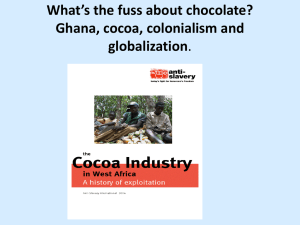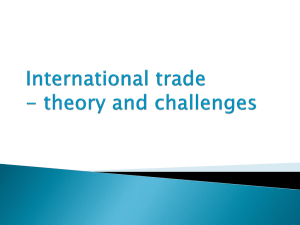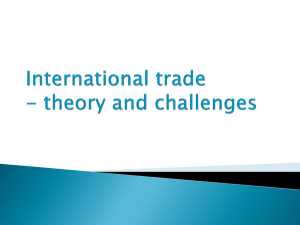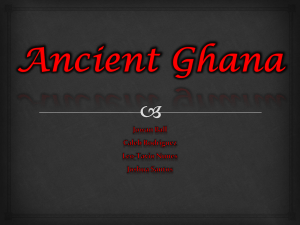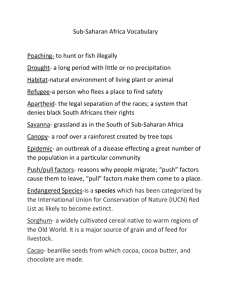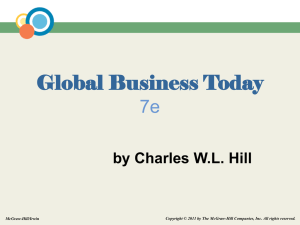Factors of Production
advertisement
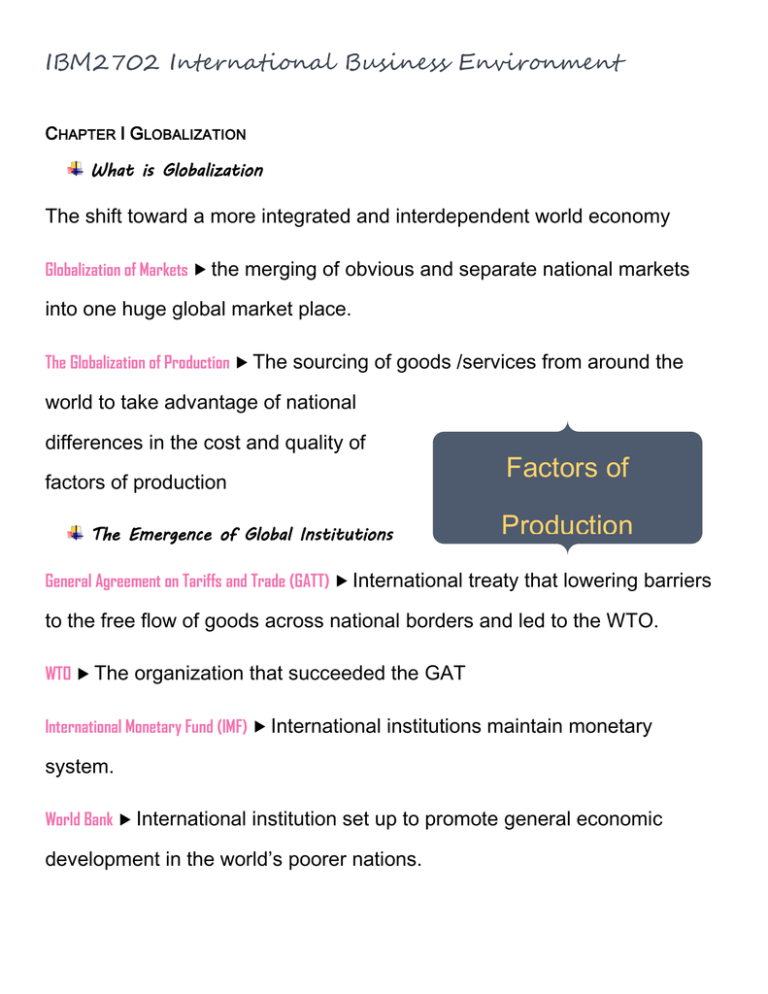
IBM2702 International Business Environment CHAPTER I GLOBALIZATION What is Globalization The shift toward a more integrated and interdependent world economy Globalization of Markets the merging of obvious and separate national markets into one huge global market place. The Globalization of Production The sourcing of goods /services from around the world to take advantage of national differences in the cost and quality of factors of production The Emergence of Global Institutions Factors of Production labor,that energy, land, General Agreement on Tariffs and Trade (GATT) International treaty lowering barriers to the free flow of goods across national borders and led to the WTO. management, and capital WTO The organization that succeeded the GAT International Monetary Fund (IMF) International institutions maintain monetary system. World Bank International institution set up to promote general economic development in the world’s poorer nations. United Nations International organization promotes peace, security and cooperation. INTERNATIONAL TRADE WHEN A FIRM EXPORTS GOODS/SERVICES CONSUMERS TO IN ANOTHER COUNTRY. Divers of Globalization FOREIGN DERIECT Two macro factors control the trend toward greater INVESTMENT globalization DIRECT INVESTMENT IN BUSINESS OPERATIONS IN A FOREIGN COUNTRY. Microprocessors and Telecommunications The Internet and World Wide Web Transportation technology Implications for the Globalization of Production Implications for the Globalization of markets The Changing Demographics of the Global economy Stock of foreign direct Investment The total accumulated value of foreign- owned assets at a given time Multinational Enterprise (MNE) firms that owns business operations in more than one country Non-U.S. multinationals The rise of Mini-Multinationals The Globalization debate E. CHAPTER 2 NATIONAL DIFFERENCES IN POLITICAL ECONOMY POLITICAL SYSTEM POLITICAL SYSTEM THE SYSTEM OF GOVERNMENT IN A NATION Collectivism and Individualism Collectivism = political system that stresses the primary of collective goals. The needs as a whole “the goal of society” Plato The republic Socialism (socialists) government ownership of the average productions 1. Communists = violent revolution and totalitarian dictatorship. 2. Social Democrats = democratic means Individualism = an individual should have freedom in his/her economic & for common goods. Political pursuits. 1. The needs as an individual 2. Aristotle ECONOMIC Democracy and Totalitarianism SYSTEM Democracy (Government is by people, elected preventatives) Totalitarianism (Government exercise absolute control) 1. Communist Totalitarianism 2. Theocratic Totalitarianism = Governs according to religious principles 3. Tribal Totalitarianism = Political party that represents the interests of a particular tribe, monopolize power 4. Right-wing Totalitarianism = Governments are backed by military or are the military officers Market Economy All product activities are privately owned. Production is determined by supply & Demand. Supplies are not restricted. Command Economy Government plans the goods & services (What to produce/How much is it) Set prices and Quantities Allocate resources for the good of society No innovation/Dynamism Mixed Economy Government and private firms share the economic LEGAL Regulate behavior and the processes. SYSTEM Common Law based on tradition, precedent, and custom Country’s legal history Cases that have come before the courts in the past The ways in which laws are applied in specific situations Civil Law based on a detailed set of laws organized into codes. Theocratic Law based on religious teachings Property rights and corruption The legal rights over the use to which a resource is put and over the use made of any income that may be derived from that resource. Private Actiontheft, piracy, blackmail, and the like by private individuals or groups. Public action and corruption violate property rights occurs when public officials cheat income, resources, or the property itself from property holders U.S. law regulating behavior regarding **Foreign corrupt practices Act the conduct of international business in the taking of bribes and other unethical actions. The Protection of intellectual property Intellectual propertythe PatentGrants product of intellectual Software activity Screenplay Music score New drug the innovator of a new product. Copyrightexclusive legal rights of authors, composers, playwrights, artists etc. Trademarkthe design and name, often officially registered, by merchants designate ** World Intellectual their product. Property Organization Paris Convention for the Protection of Industrial Property CHAPTER 3 POLITICAL ECONOMY AND ECONOMIC DEVELOPMENT DIFFERENCES IN ECONOMIC DEVELOPMENT GROSS NATIONAL INCOME (GNI)The total annual income of a nation’s residents. PURCHASING POWER PARITY (PPP)An adjustment in gross domestic per capita to reflect differences in the cost of living. HUMAN DEVELOP INDEX (HDI) The impact of a number of factors on the quality of human life in a country. POLITICAL ECONOMY AND ECONOMIC PROGRESS INNOVATION AND ENTREPRENEURSHIP ARE: The engines of growth Require a market economy Require strong property rights THE REQUIRED POLITICAL SYSTEM ECONOMIC PROGRESS CREATES DEMOCRACY Innovation Development of new products, processes organization, strategies. and GEOGRAPHY, EDUCATION, AND ECONOMIC DEVELOPMENT CHAPTER 4 DIFFERENCES IN CULTURE What is culture? A system of values and norms that are shared among a group of people and that when taken together constitute a design for living. Values and Norms Values = Abstract ideas about what a group believes to be good, right, and desirable. Norms = the social rules and guidelines that prescribe appropriate behavior in a particular INDIVIDUAL & GROUP situations. [WESTERN = INDIVIDUAL The determinants of culture Social Structure The basic social organization of a society Individuals and Groups ] ASIAN =GROUP CLASSES & CASTES [INDIA = CASTES ] AMERICAN = CLASSES Group = two or more individuals who have a shared sense of identity and interact with each other in common set of expectations about each other’s behavior. The Individual Positive Negative High degree of managerial mobility High level of entrepreneurial activity create new products and new ways of doing business between companies lack of loyalty& commitment leads to frequent move to better office, so they lost knowledge, experience and network of personal contact High degree of managerial mobility exposed to different ways of doing Difficult to make a teams business The Group Positive Employees can Build up knowledge, experience and a networkthey can perform their job effectively Create pressures for mutual self-help and collective action Negative Lack of dynamism and entrepreneurship Social stratification Social strata family background, occupation, and income Social Mobility individuals can move out of the strata into which they are born Caste system closed system that is determined by the family into which a person is born, cannot change position Class system social mobility is possible up or down depends on his or her achievements or luck Language Spoken Language Spoken & written vocabulary Unspoken Language nonverbal communication Language blunder = Advertising slogans & company documents must be translated carefully so that messages are received precisely as intended. Education Hofetede framework Hofetede framework 1. (5 dimensions) Power distance = how society deal with the fact that people are unequal in physical & intellectual capabilities. Inequality in power & wealth Greater equality 2. Individualism & Collectivism = Focus on relationship between the individual and his or her fellows. Individualist culture Individual achievement & freedom Hard work/ innovation Collectivist culture Collective goal Strong association to the group 3. Uncertainty avoidance the members can accept ambiguous situation and tolerate uncertainty. Value job security/low employee turnover Ready to take risk & change/entrepreneurship 4. Masculinity VS Femininity Masculinity Sex roles are shaped differentiated Masculine value Femininity Little differentiation between men & women Relaxed lifestyle 5. Long-term orientation Strong long-term business relationship Respect for tradition/Reciprocation of gifts Implication for international business Implication for international business 1. Cross-cultural literacy Developed 2. Ethnocentricity Avoided Chapter 5: Ethics in international business Ethical Ethical issues issues in in international international business business 1. Employment practice Wages, working hours, and working environment 2. Human right Freedom of speech/assembly/movement etc 3. Environment pollution = arise when environmental regulations in host nations are far inferior to those in the home nation. 4. Corruption Foreign corruption practices act, convention on combating bribery of foreign public officials in international business Transactions 5. Moral obligation Social responsibility Ethical dilemmas = situation in which none of the available seems ethically 5acceptable. things to do 5 things to do 1. Hiring & Promotion Hire people who have a strong sense of personal ethics 2. Organization Reward & Sanction 3. Leadership Leaders should act in manner 4. Decision making process Stakeholders: Internal = employees, stockholders External = customers, suppliers, government Moral imagination = standing the shoes of a stakeholder & ask how a proposed decision might impact them. 5. Develop moral courage Chapter 6: International Trade Theory Free Free trade trade No government intervention in international trade (no tariffs & Quotas) Have a specialize in production More efficiency export goods/ cheaper import goods International Trade Trade Theory Theory International 1. Mercantilism Maintain trade surplus (≠ trade deficit) Government intervention impose import restrictions Zero-sum game = one country gain, another losses 2. Absolute advantage Production Possibilities Frontiers (PPF) Positive-sum game = both countries benefit from trade Example Ghana South Korea Cocoa 10 hrs 40 hrs Rice 20 hrs 10 hrs Without trade Ghana South Korea Total production Cocoa 10 2.5 12.5 Rice 5 10 15 Specialization Ghana Ghana South Korea South Korea Total production Cocoa Cocoa 10 20 hrs 40 0hrs 20 Rice Rice 13.33 hrs 0 20 hrs 20 20 After Trade Ghana South Korea Total production Cocoa 14 6 20 Rice 6 14 20 Ghana South Korea Total production Cocoa 4 3.5 7.5 Rice 1 4 5 Gain 3. Comparative Advantage When a country can produce a good with lower opportunity cost than other Positive-sum game Example Without trade Ghana South Korea total production Cocoa 10 2.5 12.5 Rice 7.5 5 12.5 Cocoa Rice Specialization Ghana South Korea total production 15 0 15 3.75 10 13.75 Ghana South Korea total production Cocoa 11 4 15 Rice 7.75 6 13.75 Ghana South Korea total production Cocoa 1 1.5 2.5 Rice 0.25 1 1.25 After Trade Gain 4. Heckscher-Ohlin theory Factor endowment (land, labor, capital) The more abundant, the lower its cost Leontif Paradox 5. International product life cycle 3 stages New, Maturity, Standardized product 6. New trade theory Economic of Scale (EOS) = unit cost reductions associated with a large scale of output First mover Advantage = the first to enter the market 7. National competitive advantage Porter’s diamonds 1. Factor conditions basic & advanced 2. Demand conditions 3. Related & Supporting industries 4. Firm strategies, Structure, and rivalry Chapter 7: Political economy of inter trade Instruments of of trade trade policy policy Instruments 1. Tariffs Export tariff Import Tariff Ad valorem tariff = percentage Specific tariff = fixed charge 2. Subsidies cash payment, low interest loans, Tax breaks Pros = help domestic firms Cons = inefficient domestic producers 3. Quotas Import quotas Voluntary export restraints (VER) Tariff Rate Quotas 4. Local content requirements (LCR) 5. Administrative policies 6. Antidumping policies Dumping = Selling goods in a foreign market below their cost of production Punish foreign firms Case for for Government Government intervention intervention Case 1. Protecting Job & Industry 2. National security Protect certain industries because they are important for national security 3. Retaliation Play by the rule of the game = Trade war 4. Protecting Consumers Protect from unsafe products 5. Furthering foreign policy objectives Support their foreign policy objectives = build strong relations 6. Protecting human rights Most favored nation (MFN) 7. Protecting the environment International trade leads to higher pollution (CO2) Economic arguments for the intervention Economic arguments for the intervention 1. Infant industry argument new factories cannot compete with industries that come from developed countries 2. Strategic trade policy improve the competitive position of a domestic firm help firms gain first-mover advantage
